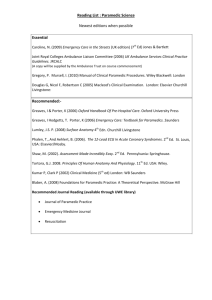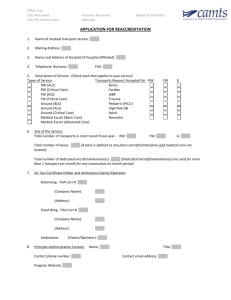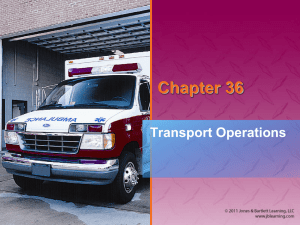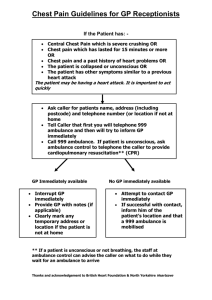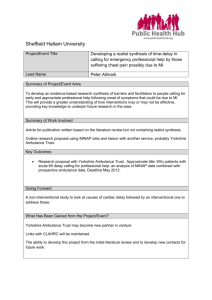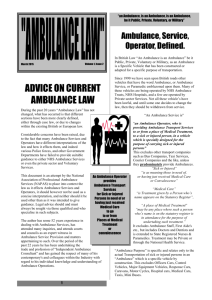THE UNITED COUNTIES OF LEEDS AND GRENVILLE
advertisement
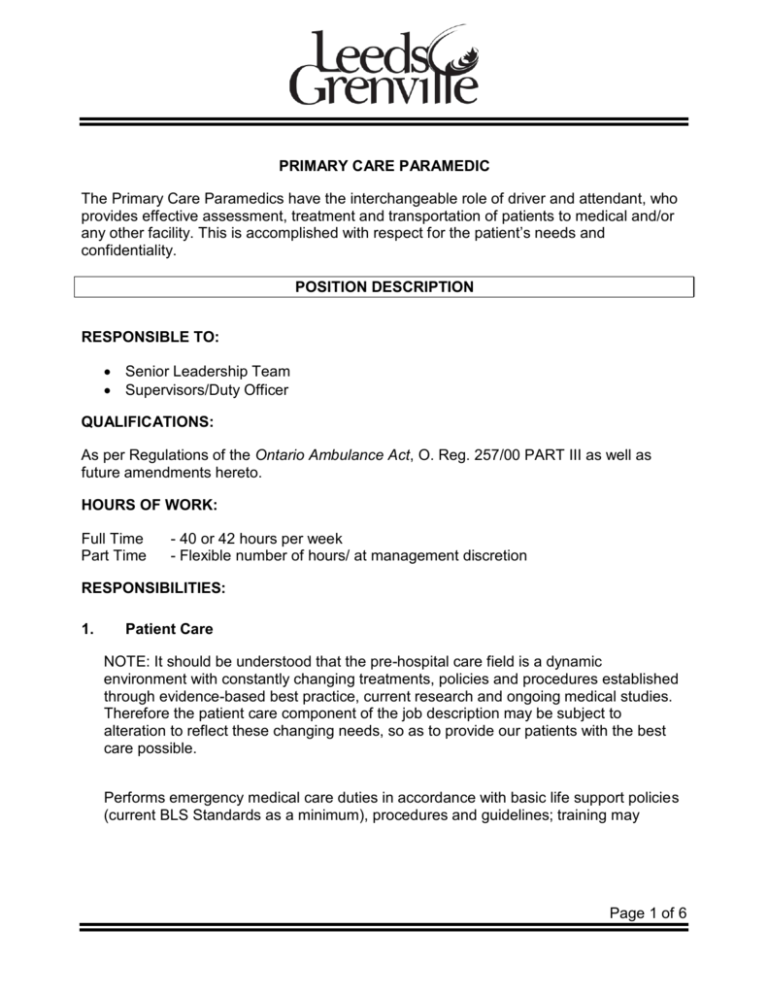
PRIMARY CARE PARAMEDIC The Primary Care Paramedics have the interchangeable role of driver and attendant, who provides effective assessment, treatment and transportation of patients to medical and/or any other facility. This is accomplished with respect for the patient’s needs and confidentiality. POSITION DESCRIPTION RESPONSIBLE TO: • Senior Leadership Team • Supervisors/Duty Officer QUALIFICATIONS: As per Regulations of the Ontario Ambulance Act, O. Reg. 257/00 PART III as well as future amendments hereto. HOURS OF WORK: Full Time Part Time - 40 or 42 hours per week - Flexible number of hours/ at management discretion RESPONSIBILITIES: 1. Patient Care NOTE: It should be understood that the pre-hospital care field is a dynamic environment with constantly changing treatments, policies and procedures established through evidence-based best practice, current research and ongoing medical studies. Therefore the patient care component of the job description may be subject to alteration to reflect these changing needs, so as to provide our patients with the best care possible. Performs emergency medical care duties in accordance with basic life support policies (current BLS Standards as a minimum), procedures and guidelines; training may Page 1 of 6 include some skills and procedures that require medical control in accordance with program standards, guidelines, methods, procedures and techniques by: • Attending at scene as warranted by priority of assignment; • Assessing scene for hazards; • Carrying out triage (establishing priority to treatment) in multiple patient situations and calling for additional assistance as required; • Being responsible for directing all aspects of patient care while attending with another Primary Care Paramedic and assisting in the provision of patient care as directed by an Advanced Care Paramedic when working as a split crew; • Conducting a primary survey of the patient to establish airway, breathing, circulatory and neurological status and disabilities; • Collecting vital signs and a medical and/or incident history, and/or cardiac monitoring readings from automatic and/or semi-automatic monitor/defibrillators; • Administering cardiopulmonary resuscitation, oxygen, and manual ventilation using bag-valve-mask, and other techniques and equipment where approved, including pulse oximeters, non-endotracheal airways, and manually or automatically triggered resuscitators to restore, improve or maintain airway patency and heart and lung function; • Monitoring intravenous fluid infusion therapy in accordance with current MOHLTC – EHS guidelines; • Operating and checking semi-automatic defibrillator to deliver electrical charges and restore an effective heartbeat, where authorized; • Immobilizing actual or suspected fractures and spinal injuries and bandaging and treating hemorrhages, wounds and environmental injuries; • Performing other emergency medical care duties as required; • Administering medications under well-defined circumstances where approved; in some services/sites may administer symptom relief drugs as authorized; (i.e.: Base Hospital SR Protocols); • Monitoring and reassessing patient to detect condition variances and reinitiating basic care procedures; this may involve skills and procedures which require medical control to restore, improve or maintain vital functions and stabilize illness and injuries; requesting directions and/or referring matters not covered by established standards and guidelines and protocols to other Page 2 of 6 qualified personnel and recording of such guidelines and direction, including the name of the person giving it; • Reporting by radio to a dispatch centre the destination, priority and patient condition and particulars and attaining direct link to base hospital as required; • Preparing documentation and reporting using medical formats and pharmaceutical terminology to provide hospital staff with a complete clinical picture for pre-hospital working assessment and prescription of treatment or to substantiate initiation of standardized protocols of care; • Ensure effective communications by using established guidelines when consulting with medical staff by radio or telephone; • Informing hospital staff and passengers of safety in and around aircraft/ambulance vehicles. 2. Transport and Transfer of Patient Responsibilities • Transports a patient to a facility as directed by the CACC communications officer directing the movements of the ambulance; • Provides ongoing patient care during transport; • Transferring patient(s) to and from vehicles, treatment centres, examining tables, stretchers and beds; • Providing the appropriate medical authorities with detailed information concerning ill and/or injured patients; • Reporting by telephone to dispatch centre all patient particulars and preparations required for return to base stations; • Completing all required forms and documentation before the end of the assigned shift and leaving with or forwarding appropriate copies to the medical facility; • Cleaning stretchers and changing linens prior to departure from medical facilities in order to prepare equipment for service; • Cleaning and restocking interior of vehicles and equipment and reporting to dispatch when available for next assignment; 3. Vehicle Maintenance and Driving • Inspect service vehicle(s) for roadworthiness, BLS inventory (according to established standards) and serviceability; • Restocks each ambulance and/or emergency response vehicle with patient care and accessory equipment after, or as soon as practical after each ambulance call; Page 3 of 6 • Maintains service vehicle(s) in a clean and sanitary condition; • Utilizes the ambulance vehicles and emergency response vehicles only for the purpose of providing ambulance service unless otherwise directed by CACC and/or the senior leadership team; • Accounts for the purchase of fuel and oil usage as required by the service; • Responds to emergency and non-emergency calls as per the rules and regulations of the Ontario Highway Traffic Act, MOHLTC Emergency Health Services and the leadership team; • Utilizes emergency warning devices as per the rules and regulations of the Ontario Highway Traffic Act, MOHLTC Emergency Health Services and Leeds/Grenville Paramedic Services; • Operates all vehicles in a safe and professional manner; • Optimizes the response time of his/her vehicle; • Wears seatbelts at all times when vehicle is in motion. It is understood that when providing patient care in the rear compartment of an ambulance that the wearing of a seatbelt may not always be possible; • Ensures that patients and passengers are safely transported, properly secured and/or wear seatbelts at all times; • Ensures the safety and security of all vehicles and equipment when left unattended, in or out of the base. 4. Education Students – provide education, experience and preceptorship for co-op and AEC students involved in field placements and other medical observers Staff Development – participates in training programs, practice sessions and any other staff education if applicable • Participates in orientation for less experienced staff; • Participates in educational programs and/or studies as determined by the Deputy Chief, Operations or Deputy Chief of Quality Assurance & Training; • Completes required service training programs involving new or replacement patient care and communications equipment; • Maintains qualifications in symptom relief and semi – automatic defibrillation, as determined by the Base Hospital and/or medical director; • Attends and successfully completes all mandatory training courses as established and required by the MOHLTC; (CME’s) Page 4 of 6 5. Documentation • Completing Ambulance Call Report (as per ACR Manual); • Completes vehicle check sheet(s) as determined by the leadership team; • Completes and signs all required controlled substances (narcotics and others) documentation as required when working in an Advanced Life Support crew configuration; • Providing incident reports, occurrence reports, accident reports and any other report(s) required by regulation, policy or which may be deemed necessary by the leadership team; • Providing copies of personnel file documentation as required by the Ontario Ambulance Act. These documents include: Photocopy of Driver’s Licence (when renewed / changed) CPR recertification certificate as mandated Photocopy of Ministry of Health Ambulance Identification badge (when renewed, reported lost, or number has changed) Proof of immunization Proof of being free of communicable diseases Completion of Secondary School Education (Diploma) Completes other documents as deemed necessary by the leadership team. Note: Employees must notify Supervisor/Duty Officer in the event that your Ministry of Health Identification card is lost or stolen. 6. Communications • While on duty, keeps the appropriate communications centre (CACC) advised of the availability of their vehicle within the ambulance service; • Reports immediately each movement of an ambulance or emergency response vehicle to the appropriate communications centre (CACC); • Is familiar with the operations of vehicle communications equipment (main and portable radios), cellular phones and/or satellite phones, and pagers; • Immediately notifies the appropriate communications centre (CACC) whenever a vehicle is removed from and/or returned to service for repair or maintenance. Page 5 of 6 7. Occupational Health and Safety • Performs all duties and tasks in a manner which ensures the safety of self and others; • Ensures ambulance and station premises are safe and clean; • Ensures that all equipment is maintained in a clean and sanitary condition; • Ensures that patient care and accessory equipment is properly and safely restrained and/or stored in vehicle(s); • Ensures that patient care and accessory equipment is maintained in proper working order; • Reports any deficiencies in station premises, vehicles and equipment; • Ensures that the patient care compartment and any equipment used is properly cleaned after each ambulance call; • Work in accordance with Occupational Health and Safety legislation, and municipal Policy and Procedures; 8. Team Functions • Effectively communicates and works with other team members in a constructive and professional manner (i.e. service staff, police, fire, dispatchers and other allied health professionals). • This teamwork will ensure the provision of quality care to our patient(s). 9. Other Related Responsibilities • Performs housekeeping duties, refurbishing of units and general maintenance on stations and grounds; • Any other duties as deemed necessary and assigned by the leadership team. Page 6 of 6


